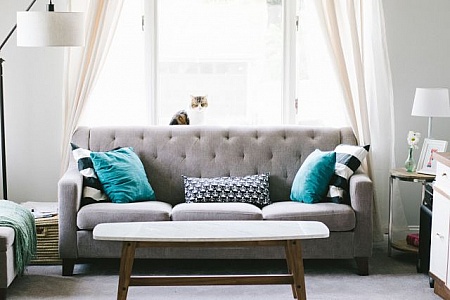In the kaleidoscope of home decor, furniture emerges as the defining brushstroke that paints the canvas of living spaces. This exploration delves into the myriad styles and trends that currently shape the landscape of furniture design, seamlessly blending functionality with aesthetic allure. From timeless classics that pay homage to craftsmanship to avant-garde statements pushing the boundaries of innovation, the evolving tapestry of furniture styles reflects a nuanced interplay of tradition, modernity, and the quest for elevated living.

Eternal Elegance: Resonance of Timeless Classics
Rooted in craftsmanship and enduring design principles, traditional furniture styles stand as the bedrock of timeless elegance. The Classical Revival draws inspiration from ancient Greek and Roman aesthetics, weaving regal columns, intricate detailing, and sumptuous upholstery into a tapestry of opulence. Queen Anne furniture, with its refined lines and dark woods, exudes a sense of grace and understated grandeur, while Colonial styles pay homage to America’s rich heritage through simple, sturdy designs.
These classics, characterized by meticulous attention to detail and artisanal mastery, remain revered choices for those seeking an enduring sophistication in their home decor. They form a bridge between the rich legacy of the past and the contemporary aspirations of today’s discerning homeowners.
Mid-Century Modern: Time-Tested Simplicity
The Mid-Century Modern movement, born in the post-war era, continues to exert a profound influence on contemporary home decor. Its emphasis on clean lines, organic shapes, and functionality has bestowed a timeless appeal upon its iconic pieces. Designs from luminaries like Charles and Ray Eames and Eero Saarinen, marked by tapered legs, bold geometric patterns, and the use of pioneering materials like molded plastic and plywood, seamlessly integrate into modern interiors.
The enduring popularity of Mid-Century Modern is a testament to its ability to transcend temporal boundaries, offering a perfect marriage of form and function that resonates with today’s design sensibilities.
Contemporary and Modern: Fluid Elegance
Contemporary and Modern styles, often used interchangeably but each with its distinct nuances, capture the zeitgeist of current design trends. Contemporary design embraces the current moment, showcasing a fluid blend of styles, materials, and shapes. It allows for a harmonious fusion of traditional elements with avant-garde innovation, resulting in a dynamic and ever-evolving aesthetic.
On the other hand, Modern design, rooted in the mid-20th century, adheres to a more defined set of principles. Clean lines, open spaces, and a focus on functionality characterize this style. The use of materials like steel, glass, and concrete exemplifies the movement’s commitment to innovation and simplicity.
Eclectic Fusion: Harmony Amidst Diversity
The rise of eclectic decor mirrors a societal shift towards embracing diversity and personal expression. Eclectic furniture styles draw inspiration from various eras, cultures, and design movements, resulting in spaces that are uniquely individualistic. The key to successful eclectic decor lies in creating cohesion amidst diversity, curating a narrative that feels intentional rather than chaotic.
Picture a room where a Victorian-era chaise lounge coexists harmoniously with a sleek Mid-Century Modern coffee table, while vibrant Moroccan rugs accentuate a contemporary sofa. This seamless fusion of styles creates a dynamic and visually engaging environment that celebrates the diversity of design, reflecting the eclectic tastes of today’s homeowners.
Industrial Chic: Urban Grit and Glamour
Originating from repurposed industrial spaces, Industrial Chic injects an urban edge into home decor. Defined by raw, unfinished materials like exposed brick, steel, and reclaimed wood, this style celebrates the inherent beauty of utilitarian elements. Furniture pieces often feature sturdy metal frames, distressed finishes, and a focus on functionality.
The juxtaposition of rough textures with refined elements, such as polished metals or leather upholstery, creates a distinctive aesthetic that resonates with those seeking a bold and edgy design statement. Industrial Chic is an homage to urban grit and glamour, bringing an authentic touch of the city into residential spaces.
Minimalism: A Serene Retreat
Minimalism, an influential movement advocating for simplicity and functionality, is a design philosophy that has found a timeless place in contemporary home decor. Striving to declutter and pare down to the essential, Minimalist furniture often features clean lines, neutral color palettes, and a focus on open spaces. Each piece is carefully selected to serve a purpose while contributing to an overall sense of tranquility.
Minimalist furniture embraces hidden storage solutions, multifunctional designs, and meticulous attention to detail. The result is an environment that exudes a serene elegance, inviting inhabitants to appreciate the beauty of simplicity and live with only what truly matters.
Sustainability in Design: Greening the Aesthetic
As environmental consciousness takes center stage, sustainability becomes a driving force in furniture design. Eco-conscious furniture trends focus on responsibly sourced materials, waste reduction, and environmentally friendly production processes. Designers increasingly incorporate recycled or upcycled materials, such as reclaimed wood or recycled metal, into their creations.
Sustainable furniture styles span various aesthetics, from rustic reclaimed wood tables to sleek, modern pieces crafted from recycled plastics. This emphasis on sustainability not only aligns with eco-friendly values but also reflects a broader societal shift towards conscious consumerism in the realm of home decor.
Smart Furniture: Living in the Future
In the era of smart homes, furniture is undergoing a transformation with the integration of technology. Smart furniture combines innovative design with technological functionalities, enhancing the user experience. From sofas with built-in USB ports to coffee tables with wireless charging capabilities, these pieces seamlessly weave technology into the fabric of daily life.
Beyond mere gadgets, smart furniture extends to adaptive and multifunctional designs. Imagine a dining table that transforms into a work desk or a sofa that adjusts its recline based on your preferences. As technology continues to advance, the boundaries between furniture and cutting-edge innovation blur, offering a glimpse into the future of functional and tech-savvy living spaces.
Biophilic Design: Nature-Inspired Harmony
Biophilic design, an emerging trend, seeks to bring nature indoors by incorporating natural elements, organic shapes, and sustainable materials into furniture design. The use of materials like bamboo, rattan, or cork reflects a commitment to both aesthetics and environmental consciousness.
Furniture inspired by biophilic design often features planters, natural textures, or shapes reminiscent of organic forms. The goal is to create spaces that foster a sense of well-being by integrating the calming influence of nature into the home. Biophilic design not only enhances the aesthetic appeal but also promotes a holistic and harmonious living environment.
Conclusion
The world of furniture styles and trends is a dynamic landscape where tradition harmonizes with innovation, and the past converges with the future. From the enduring elegance of timeless classics to the avant-garde statements of futuristic smart furniture, the choices available to homeowners today are vast and diverse. Each style and trend reflects not only the evolution of design preferences but also the aspirations and values of contemporary living.
As homeowners navigate this rich tapestry of possibilities, the key lies in understanding personal preferences, considering the functionality of each piece, and embracing the aesthetic that resonates with one’s lifestyle. The symphony of furniture styles in contemporary home decor is an ever-evolving composition, inviting individuals to curate spaces that reflect their unique identity while embracing the beauty of design in all its diverse forms.









No Comment